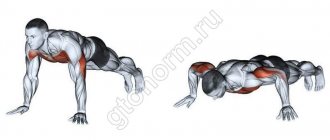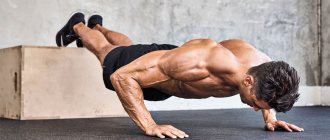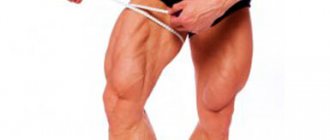How to learn to do explosive push-ups. Exercise options
There are several options for performing explosive push-ups. We have selected the most effective ones for you and placed them in order of increasing complexity. In each case, the starting position is the same - lying down. Next come variations with the position of the arms, the use of the leg muscles, etc.:
With your hands off the floor
- We place our hands slightly wider than our shoulders, lower our chests to the floor by bending our arms at the elbow joints. We push off from the floor with both hands, the hands come off the floor, but do not change their position - we push off from the floor - the “hands off” phase - we touch the floor with our palms.
- Place your hands shoulder-width apart, lower your chest to the floor and push off powerfully from the floor. In the “flight” phase, we spread our arms wider than our shoulders and land in this position. Having landed, we perform push-ups from the floor with a wide grip, push off again and in the “flight” phase we change the position of the hands to the original one, that is, shoulder-width apart.
- Before starting the exercise, place small bars 10-15 centimeters high on both sides of the hands. They can be placed both on the outside and on the inside of the hands, but at a short distance from the arms. We lower our chests to the floor, sharply straighten our arms at the elbow joints and tear them off the surface, moving our palms onto pre-prepared bars. We perform push-ups on the bars, push off again and return to the floor.
- Starting position - hands shoulder-width apart. Next, we lower our chest to the floor, then sharply straighten our arms and throw them above our heads, as if we were trying to dive into water. At the end of the exercise, we land in the starting position.
- Place your hands shoulder-width apart and do a push-up. Next, we push off the floor with our hands and, in the “flight” phase, make one clap in front of the chest and one clap behind the back, after which we lower ourselves onto our palms.
Explosive push-ups. Plyometric push-ups for strength and speed training
Plyometrics is a training style that maximizes the strength and speed of an athlete. Plyometric push-ups are performed with explosive force and maximum amplitude. Plyometric push-ups differ from simple push-ups in that from the bottom position the athlete makes a sharp jerk upward and lifts his hands off the floor in a kind of jump. This adds movement: clapping your palms together, your palms on your hips or behind your back.
Performing this unique exercise is possible only with controlled and synchronized muscle work. It is thanks to the jump that the athlete’s explosive power develops. The exercise is also good because it allows you to burn a significant amount of calories in a short workout.
The benefits of plyometric push-ups
Any athlete can learn this. You just need to constantly monitor the execution technique. Push-ups will help increase performance in other basic exercises and generally strengthen the ligamentous apparatus.
With regular implementation, the following indicators improve:
- coordination and balance;
- explosive strength of the shoulder muscles;
- speed of performing presses;
- neuromuscular connections between the brain and the torso muscles.
Contraindications
Since plyometrics require serious effort, there are also contraindications. It is not recommended for diseases and injuries of the joints, inflammation in the deltoid muscles, and problems with tendons. In this case, you can replace push-ups with dumbbell presses on an incline bench. Lever trainers will also work.
Execution Rules
Starting position: lying down, back straight, arms slightly wider than shoulder-width apart, gaze ahead.
Performance:
- do several ordinary push-ups from the floor in a short amplitude, without full extension of the elbows;
- make a sharp jerk upward from the bottom position using an impulse jump;
- on a powerful exhalation, quickly and sharply lift your palms off the floor;
- at the moment of “hanging”, clap in front of you, while the muscles of the abs and buttocks statically tense;
- land on your palms with your elbows slightly bent, immediately lower to the bottom position;
- do 10-12 similar repetitions.
Varieties of Plyometric Push-ups
If you have not encountered plyometrics before, you need to start with the simplest option - push-ups with your hands briefly lifted off the floor. Having mastered it, try to fly up as high as you can. If you can do 20 repetitions, proceed to the following steps:
- push-ups with a clap in front of you - the traditional version described above;
- with your hands touching your shoulders - in a cross motion with your palms, touching the right and left shoulders requires more effort than with a simple plyometric push-up;
- with a clap on the hips - requires maximum control over execution;
- with clapping your palms behind your back - high level of difficulty, try to do it on a soft mat the first few times;
- with a turn - for the most prepared, a 360° turn is considered almost an acrobatic trick.
An athlete who performs even a couple of varieties of push-ups is worthy of the title “Superman”. This is an ideal exercise for developing strength, speed and endurance.
What muscles work?
Despite the fact that the mechanics of explosive push-ups are in many ways similar to simple push-ups, the number of muscle groups involved is significantly higher (in the most complex variation). Let's take a closer look.
| Muscle group | Load type | Emphasis (compared to simple push-ups) |
| Pectoral muscles | Dynamic | Significant |
| Core muscles | Static | Absent |
| Abdominal muscles | Dynamic | Absent |
| Muscles of the lumbar region | Static | Minor |
| Extensor triceps | Dynamic | Minor |
| Biceps hamstrings | Static | Absent |
| Gluteus muscle | Static | Absent |
| Calf muscle | Static | Absent |
| Soleus | Static | Absent |
| Front delts | Dynamic | Significant |
| Carpal muscles | Dynamic | Significant |
| Biceps flexor | Stabilizing | Significant |
As you can see from the map, more muscle groups are involved. In addition, the emphasis on the target muscles allows you to get a deeper study.
Explosive push-ups. Push-up technique with clap - developing explosive strength
Clapping push-ups are one of the modifications of the usual exercise aimed at developing the so-called explosive strength. The essence of explosive loading is that the athlete needs to develop a powerful force in a short period of time. This is a plyometric exercise, the same in meaning as, for example, squat jumps.
The benefits of such exercises lie primarily in developing strength and speed, and only then in increasing muscle size. Therefore, they are often used in the training of professional athletes. Push-ups with clap are practiced in preparation for boxing and other martial arts, gymnastics, etc. Bodybuilders use plyometrics to improve strength indicators, for example, allowing them to work with heavy weights.
Muscle work
Push-ups with clap actually use the same muscles that work when performing the classic version, namely:
- pectoralis major muscles;
- triceps;
- deltoid.
Of course, during the exercise, many other muscle groups also receive load - this is the undoubted benefit of almost any push-ups. The abdominal muscles keep the body in a straight position, the entire shoulder girdle works, the latissimus muscles are activated, and the leg muscles receive a static load.
Preparation
If you are just planning to learn how to do push-ups correctly in this way, we recommend that you proceed gradually to prepare your body for the load and avoid the possibility of injury. The most obvious type of injury is falling to the floor when you simply do not have time to clap.
Firstly, it is advisable to learn how to do push-ups in the usual way, using different hand positions. This will strengthen the right muscles and prepare you for the challenge.
Second, once you feel ready to move on, start performing classic push-ups faster and more aggressively, creating an explosive load as you rise to the top. At first, try to simply straighten your arms with a quick and powerful force, then, when you feel confident, try lifting your arms off the floor (without clapping).
Over time, you will realize that you are already jumping high enough to make the clap. So, it's time to disassemble the equipment!
Execution technique
Take the starting position - lying down (on your palm), as in regular push-ups. The arms are placed slightly wider than the shoulders, the back is straight, the body and legs are in one line.
- From the starting position, lower yourself to the lowest point, inhaling, bending your elbows and bringing your chest closer to the floor (it is not necessary to touch the floor). Keep the body level, lowering to parallel with the floor.
- Push up with a powerful and fast (explosive) force, while exhaling, pushing your body up with such force that it will be enough to clap your hands in front of you without falling.
- Make a clap and return your hands to their original position.
- Lower yourself down again until parallel to the floor and do the next repetition. Repeat as many times as necessary.
There are more complicated execution options: clapping on the chest, behind the head or behind the back, as well as performing with not only the arms but also the legs lifted off the floor at the same time. The more complex the element that needs to be performed while in the air, the more time it will take. Therefore, the meaning of such complications is always the same - you need to jump as high as possible.
Of course, such tricks look quite impressive, but they are not at all necessary. Simply try to jump higher to get the required difficulty and reduce the risk of injury.
Contraindications
Everything here is banal. Injuries to the elbow joints and hands are a reason to refrain from performing push-ups with cotton. All the benefits of the exercise in this case will be negated.
Also, the exercise is contraindicated for people who are overweight, as it causes excessive compression load.
Useful tips
The benefits of performing the exercise will be maximum if you pay attention to the following important points:
- Don't skip your warm-up. Be sure to warm up before you begin your workout.
- Keep your body upright. Resist the urge to lift yourself off the floor, helping yourself with pelvic movements.
- Graduality and once again gradualness. If you are a beginner and decide to master push-ups with clapping, increase the difficulty in stages: first regular push-ups, then a sharp, powerful and quick release to the top point, then jumping without clapping and only then add clapping.
- It is not necessary to use additional weights (and it is problematic). Better try to jump as quickly and as high as possible.
Nuances
Before starting this technique, it is important to make sure that the body is ready for this. It is not difficult to determine: a person should not be more than ten kilograms of excess weight. Regular push-ups should ideally be easy, as should regular jumping jacks. Then it is possible to do such gymnastics.
Push-ups with jumping from the floor sometimes fail at first because the person’s vestibular apparatus is not sufficiently developed, and it is difficult to land straight, maintain balance and continue gymnastics.
It is possible to improve this apparatus in special simulators, but if you practice a little in standing on one leg with your eyes closed, this will also give results.
During such training, there is a high risk of hitting your face. That's why you shouldn't rush and immediately start complex gymnastics. It’s better to first master a basic exercise where you don’t need to jump with your arms and legs at the same time. It will develop approximately the same muscles, but will not be as dangerous.
What can be replaced
Sometimes it is difficult or impossible for a person to perform this technique, but at the same time the task is to pump up the same muscles that mainly work during such gymnastics.
It’s not difficult to choose replacement exercises, but you will have to use several techniques instead of one:
- Burpee exercise;
- simple push-ups;
- pull-ups;
- hanging knee raises.
Push-ups are explosive. What is explosive force
Explosive strength is the ability to exert the greatest amount of force in the least amount of time. During explosive movements, the muscles contract very quickly, almost instantly. At the same time, not only they experience the load, but also the nervous system, which ensures a rapid response of muscle fibers to the signal to contract.
Explosive strength often develops in parallel with muscle reactivity—the ability to quickly switch from eccentric to concentric contractions.
Concentric contractions occur when muscles change body position against resistance, while eccentric contractions occur when muscles stretch in response to the gravity of a limb or load.
During exercises to develop only explosive strength, there is no stretching phase: the muscles quickly move from a relaxed state to an active one. If during an exercise the muscles are not just tensed, but pre-stretched, this also develops reactive ability.
Let's look at it with an example. If jumping onto a hill is performed from a relaxed state, for example, from a sitting position on a stand (the athlete is sitting, the muscles are relaxed), then only explosive force develops. If, before a jump, an athlete does a deep squat, stretching the muscles, reactive ability also develops.
Quick push-ups. Push-ups with normal hand position
These are push-ups in which your hands are shoulder-width apart. This is probably the most basic exercise for those who have just decided to play sports. It uses several different muscle groups and develops endurance, speed and explosiveness.
To perform this element, take a pose with your hands shoulder-width apart. It is very important to learn how to do push-ups correctly, the effect will be better and you will look much more harmonious from the outside. Having taken the starting position, lower your body down, maintaining a straight line in your legs and back. There is no need to bend or twist, use only the strength of your arms. You can do push-ups either quickly or slowly, depending on what you want to achieve. Quick push-ups will increase your arm speed and build explosive power. Such push-ups are most often practiced in martial arts.
Slow push-ups are much more difficult to perform and are therefore considered more effective. They increase your strength and endurance, and also promote muscle growth.
You can do push-ups by pressing your elbows to your body, or by spreading them out to the sides. By pressing your elbows, you load the triceps to a greater extent, and by spreading them out to the sides, you load the chest muscles. The number of push-ups depends only on your capabilities, but remember, the main thing is not how many repetitions you can do, but how many push-ups you can do correctly.
Why and to whom?
Why and who needs explosive push-ups? There are several main tasks they perform. Due to this they are often used:
- Boxers and other martial arts athletes. Explosive push-ups directly affect the speed, placement and power of the blow - which is especially important in combat.
- Crossfitters – to develop functional strength.
- People who want to soon acquire sculpted, albeit not very large, muscles.
The latter is especially interesting since speed and explosive exercises are most often used by Hollywood actors. By stimulating the deep layers of muscles that are usually not involved during basic exercises, rapid growth occurs. This is comparable to the growth effect of a person who has never played sports in his life. In the first 2 months of classes, great progress is felt, which then slows down.
Explosive exercises allow already trained athletes to achieve this effect.











